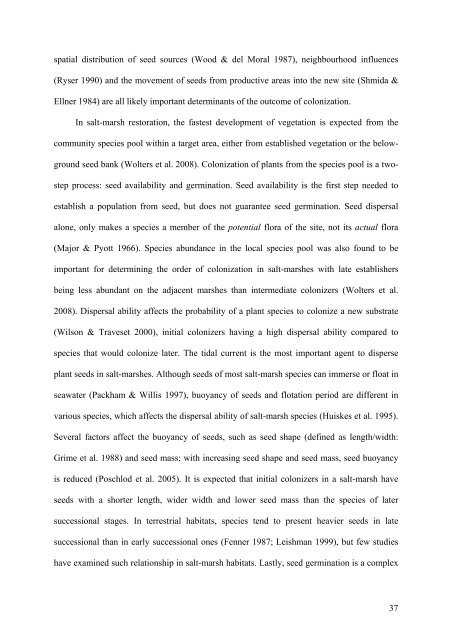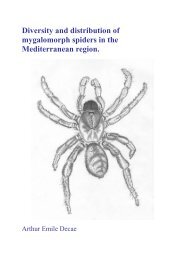PhD Reza Erfanzadeh 2009 - Ghent Ecology - Universiteit Gent
PhD Reza Erfanzadeh 2009 - Ghent Ecology - Universiteit Gent
PhD Reza Erfanzadeh 2009 - Ghent Ecology - Universiteit Gent
You also want an ePaper? Increase the reach of your titles
YUMPU automatically turns print PDFs into web optimized ePapers that Google loves.
spatial distribution of seed sources (Wood & del Moral 1987), neighbourhood influences<br />
(Ryser 1990) and the movement of seeds from productive areas into the new site (Shmida &<br />
Ellner 1984) are all likely important determinants of the outcome of colonization.<br />
In salt-marsh restoration, the fastest development of vegetation is expected from the<br />
community species pool within a target area, either from established vegetation or the below-<br />
ground seed bank (Wolters et al. 2008). Colonization of plants from the species pool is a two-<br />
step process: seed availability and germination. Seed availability is the first step needed to<br />
establish a population from seed, but does not guarantee seed germination. Seed dispersal<br />
alone, only makes a species a member of the potential flora of the site, not its actual flora<br />
(Major & Pyott 1966). Species abundance in the local species pool was also found to be<br />
important for determining the order of colonization in salt-marshes with late establishers<br />
being less abundant on the adjacent marshes than intermediate colonizers (Wolters et al.<br />
2008). Dispersal ability affects the probability of a plant species to colonize a new substrate<br />
(Wilson & Traveset 2000), initial colonizers having a high dispersal ability compared to<br />
species that would colonize later. The tidal current is the most important agent to disperse<br />
plant seeds in salt-marshes. Although seeds of most salt-marsh species can immerse or float in<br />
seawater (Packham & Willis 1997), buoyancy of seeds and flotation period are different in<br />
various species, which affects the dispersal ability of salt-marsh species (Huiskes et al. 1995).<br />
Several factors affect the buoyancy of seeds, such as seed shape (defined as length/width:<br />
Grime et al. 1988) and seed mass; with increasing seed shape and seed mass, seed buoyancy<br />
is reduced (Poschlod et al. 2005). It is expected that initial colonizers in a salt-marsh have<br />
seeds with a shorter length, wider width and lower seed mass than the species of later<br />
successional stages. In terrestrial habitats, species tend to present heavier seeds in late<br />
successional than in early successional ones (Fenner 1987; Leishman 1999), but few studies<br />
have examined such relationship in salt-marsh habitats. Lastly, seed germination is a complex<br />
37










